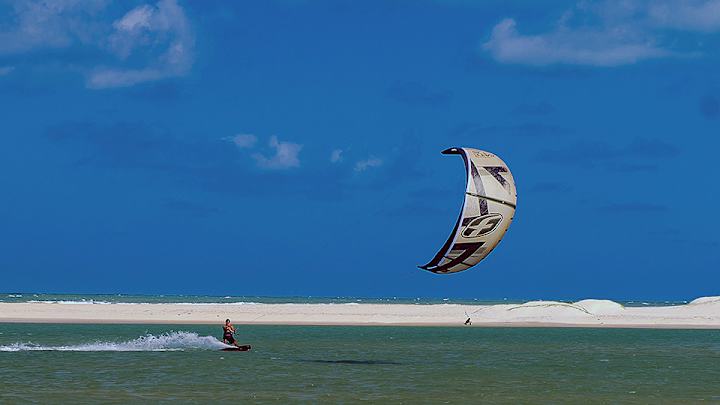Tech Talk: How design and materials determine kiteboard performance

Watching a kiteboarder put sail to the wind and slice through—and often well above—the water off the coast of California or Hawaii, Spain or Brazil, it's easy to be dazzled by the grace and speed on display. But don't lose sight of the board underfoot. For this seemingly elemental pursuit rests solidly on some impressive technology.
What are the key types of a kiteboard?
Twintip and directional. The twintip offers versatility, allowing boarders to go either direction. This also makes it the easiest type of board on which to to learn, according to Lars Moltrup, an engineer for the surf/kiteboard company Naish, and a board you can do many things with. At Naish, Moltrup creates eight different types of twintips, everything from beginner and intermediate models to the high-performing pro-level freestyle boards seen on the world tour.
A directional board looks more similar to a traditional surfboard. Designed to go in one direction only, it is used mainly in waves or light winds.
No matter the style, Moltrup says that even as advances are made in shaping boards to bring more variety to the market, there is “no such thing as a perfect shape for a kiteboard.” Finding the best board depends on the user’s size and weight, his or her riding style, the water conditions and even the size of the kite.
What are the key materials in a kiteboard?
Getting pushed, probed and tested to the limit at Red Bull endurance camp
Again we have to differentiate between the two styles. A twintip traditionally features a wood core covered on top and bottom with fiberglass, carbon fiber or basalt fiber, Moltrup says. Then rails—similar to what you would see in snowboard construction—of a plastic composite protects the board against impact. A plastic topsheet covers the entire board for protection and to showcase graphics.
The direction boards use a foam core, the same as in surfboards. But since kiteboarding applies more stress than surfing, the boards get reinforced with at least four layers of material on the bottom and six layers on the deck, often differing weights and weaves of fiberglass combined with bamboo veneer for additional strength.
What are the benefits of each material?">
The most common material you’ll find, fiberglass, offers relatively low weight and a good flex, making it a popular choice for composite construction, Moltrup says. But if you want to step up into a premium board, you’ll find carbon fiber with its low weight-to-strength ratio. Even though it comes relatively brittle, “it provides the best pop you can have in a kiteboard and is used in any high-performance model manufactured by Naish.”

The newcomer to the kiteboarding material list, basalt fiber, gets derived from melted volcanic rock spun into fiber. Somewhere between fiberglass and carbon fiber, basalt fiber sill offers quality flexibility and a “lively feel with low weight.”
For the core, the foam offers flotation on the directional boards and the wood core gives twintip boards added strength, structure and flexibility.
What key aspects differentiate boards?">
Moltrup says the shape, outline, rocker (curvature) and construction make up the four main areas of a kiteboard, each able to impact the performance.
The shape affects how much grip the board has once pressure is placed on it and how it feels from jump to landing. The outline determines a board’s ride through the water and how a board feels when it springs, and the rocker determines how a board handles in differing water conditions.
The construction, though, changes the stiffness and flex of the board. A soft board may prove comfortable for a beginner, but without enough springback to provide “pop” for the next jump for a performance-minded rider, Moltrup says.
A pop that comes from engineering board technology.
Tim Newcomb covers stadiums, design and gear for Sports Illustrated. Follow him on Twitter at @tdnewcomb.
